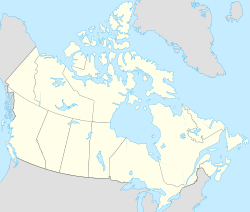Portage la Prairie, Manitoba
| Portage la Prairie | ||
|---|---|---|
| City | ||
| City of Portage la Prairie | ||

Clockwise from top left to centre: City Welcome Sign, Aerial View of Portage la Prairie, World's Largest Coca-Cola Can, Birds' Eye View of Crescent Lake and Island Park, Waterfront Active Transport Route, Island Park, City Hall
|
||
|
||
| Nickname(s): Portage, P. la P., Plaptown | ||
| Motto: Progress | ||
| Location of Portage la Prairie in Manitoba | ||
| Coordinates: 49°58′22″N 98°17′31″W / 49.97278°N 98.29194°WCoordinates: 49°58′22″N 98°17′31″W / 49.97278°N 98.29194°W | ||
| Country | Canada | |
| Province | Manitoba | |
| Region | Central Plains | |
| Established | 1738 (Fort La Reine) | |
| Settled | 1851 (village) | |
| Incorporated | 1880 (town) 1907 (city) |
|
| Government | ||
| • Type | Mayor–council government | |
| • Mayor | Irvine Ferris | |
| • City Council | Brent Budz, Liz Driedger, Melissa Draycott, Ryan Espey, Brent Froese, Wayne Wall | |
| • Member of Parliament (MP) | Candice Bergen | |
| • Member of Legislative Assembly (MLA) | Ian Wishart | |
| Area | ||
| • Land | 24.68 km2 (9.53 sq mi) | |
| • Metro | 2,029.94 km2 (783.76 sq mi) | |
| Elevation | 261 m (856 ft) | |
| Population (2016) | ||
| • City | 13,304 (5th) | |
| • Density | 539.1/km2 (1,396/sq mi) | |
| • Metro | 20,494 ('06 Census) | |
| • Metro density | 10.1/km2 (26/sq mi) | |
| Time zone | Central Time zone (UTC-6) | |
| Area code(s) | 204 | |
| Website | www.city.portage-la-prairie.mb.ca | |
Portage la Prairie /ˈpɔːrtᵻdʒ lə ˈpreɪri/ is a small city in the Central Plains Region of Manitoba, Canada. As of 2016, the population was 13,304 and the land area of the city was 24.68 square kilometres (9.53 sq mi). Portage la Prairie is located approximately 75 kilometres (47 mi) west of Winnipeg, along the Trans-Canada Highway (located exactly between the provincial boundaries of Saskatchewan and Ontario), and sits on the Assiniboine River, which flooded the town persistently until a diversion channel north to Lake Manitoba (the Portage Diversion) was built to divert the flood waters. The city is surrounded by the Rural Municipality of Portage la Prairie.
According to Environment Canada, Portage la Prairie has the most sunny days during the warm months in Canada.
It is the administrative headquarters of the Dakota Tipi First Nations reserve.
The area was first inhabited by Indigenous peoples (Plains Indians), long before European settlers began to arrive prior to 1850. In September 1738, after the fur trade had extended into Western Canada. Pierre Gaultier de Varennes, sieur de La Vérendrye (a French Canadian explorer and fur trader) built Fort La Reine north of the Assiniboine River to serve as a fur trading post, and provide the explorers with a "home" operating base, from which they would explore other parts of central Manitoba and western North America.
...
Wikipedia



